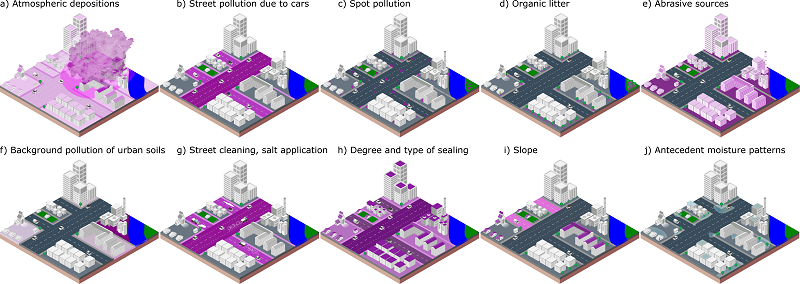Work package 3 (WP3) of the WATERUN project is organised by the ecohydrology team at the Institute of Ecology, Technical University Berlin (TUB). Our research focus lays on the modelling and scaling of water and pollutant fluxes within complex environmental systems such as urbanised landscapes.
In our sub-project, we will focus on the connectivity assessment and critical source area identification of urban diffuse pollution. Source control, i.e., pollution prevention, constitutes a fundamental step towards minimising the occurrence of pollutants in urban water runoff. Diffuse pollution originates from multiple sources stemming from the complex city layout. In an extensive review, we described the wide range of potential source areas, such as heavy metals, oil and organic salts from roads, sidewalks, car parks and different roof surfaces, organic and other litter from urban green (e.g., parks, yards, street trees) and contaminants due to atmospheric deposition. At our department, we recently developed a strategy for categorising all urban patterns that dominate or influence diffuse pollution, considering their intrinsic spatiotemporal patterns and dynamics. An application of this source-area categorisation would need to consider pollution patterns that accumulate on surfaces during rain-free periods, as well as static pollution patterns, management patterns that influence pollution structure, such as cleaning or de-icing measures, and hydrological response factors that influence the generation of overland flow or infiltration. Until now, no management tool exists to sample and collate this information on pollution type and its spatial composition and temporal dynamics.
The goal of our sub-project is to set up a diffuse pollution identification tool, which will help to study the simultaneous dynamics of pollutant build-up and pollutant connectivity as a function of rainfall magnitude, timing and climate prediction for sites in the cities of Santiago de Compostela (Spain) and Aarhus (Denmark). Knowledge of urban connectivity will help urban drainage managers to identify when and where connectivity patterns need to be maintained or altered (e.g., by installing green infrastructure). The connectivity analysis will guide future re-design of urban drainage strategies towards more targeted pollution control, to be more cost-effective and to move towards active management yielding zero pollution.
The team comprises of Prof. Eva Paton (PI), research associates Dr. Nasrin Haacke and MSc Boney Anna Joseph. Dr. Haacke will take an external advisory role on diffuse pollution, while Ms Joseph, who recently joined as a PhD student, will work on developing the diffuse pollution identification tool.

Figure 1: Spatial source area patterns that dominate or influence urban diffuse pollution (Paton and Haacke, 2021)
Authors: Eva Paton, TUB; Nasrin Haacke, BAM and TUB
Date: 23.02.2023